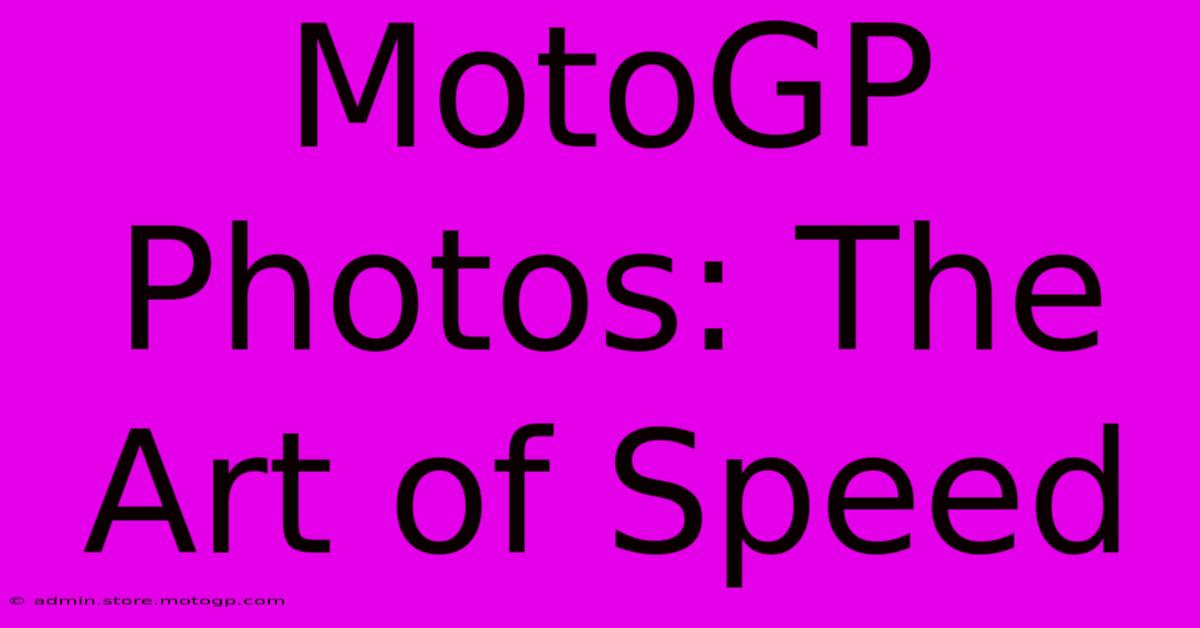MotoGP Photos: The Art Of Speed

Table of Contents
MotoGP Photos: The Art of Speed
MotoGP. The name conjures images of screaming engines, breathtaking speed, and gravity-defying maneuvers. But beyond the roar of the crowd and the thrill of the race lies a different kind of beauty: the artistry captured in MotoGP photos. These images freeze moments of intense action, revealing the skill, precision, and sheer power of these incredible machines and the riders who dare to tame them. This article delves into the world of MotoGP photography, exploring what makes these shots so captivating and the techniques that bring them to life.
Capturing the Essence of Speed
The challenge of photographing MotoGP isn't just about capturing a fast-moving object; it's about capturing the feeling of speed. A truly great MotoGP photo doesn't just show a bike leaning into a turn; it makes you feel the G-forces, the adrenaline, the sheer risk involved. This requires a masterful understanding of several key elements:
1. Shutter Speed: The cornerstone of any action photography, shutter speed dictates how much light reaches the sensor. For freezing the motion of a MotoGP bike hurtling down the track at over 200 mph, incredibly fast shutter speeds – often exceeding 1/2000th of a second – are essential. Slower shutter speeds can create motion blur, which can be artistically effective to emphasize speed, but requires precise control to avoid completely blurry images.
2. Aperture: The aperture controls the depth of field, determining how much of the image is in sharp focus. A wide aperture (low f-number) creates a shallow depth of field, blurring the background and drawing focus to the bike and rider. This technique isolates the subject and accentuates the feeling of speed and movement. A narrower aperture (high f-number) increases depth of field, keeping more of the scene in focus, which can be useful for capturing details of the track or the surrounding environment.
3. ISO: The ISO setting determines the sensitivity of the camera's sensor to light. In bright sunlight, a lower ISO is ideal for minimizing noise. However, in lower light conditions (like overcast days or twilight shots), a higher ISO might be necessary, although this can increase image noise. Finding the balance between sufficient light and minimal noise is crucial.
Beyond the Technical: The Art of Composition
Technical proficiency is only half the battle. Great MotoGP photography also requires an artistic eye. Consider these compositional elements:
Leading Lines: Utilize the track itself, barriers, or even the lines painted on the tarmac to guide the viewer's eye towards the main subject. This creates a dynamic and engaging composition that emphasizes the speed and direction of the bike.
Rule of Thirds: Instead of placing the subject directly in the center, position it along one of the imaginary lines that divide the frame into thirds, both horizontally and vertically. This creates a more balanced and visually appealing image.
Dramatic Angles: Experiment with different camera angles to capture unique perspectives. Low angles can make the bikes appear larger and more powerful, while high angles can show the entire track and the context of the race.
The Emotional Impact of a Great MotoGP Photo
The best MotoGP photos are more than just technically proficient; they evoke emotion. They capture the intensity of the competition, the skill of the riders, and the sheer beauty of these powerful machines in motion. They tell a story, even a single frozen moment, capturing the raw power and the calculated precision of the sport. The adrenaline, the concentration etched on the rider's face, the blur of speed – these are the elements that elevate a photograph from a mere snapshot to a piece of art. By understanding the technical aspects and the artistic principles involved, photographers can truly capture the essence of MotoGP and share the excitement with the world.
Conclusion: More Than Just a Race
MotoGP photography is a captivating blend of technical skill and artistic vision. It's a testament to the power of the image to convey emotion, excitement, and the raw energy of one of the most thrilling sports in the world. The next time you see a stunning MotoGP photo, take a moment to appreciate the skill, dedication, and artistic eye that went into creating it. It’s a glimpse into a world of speed, skill, and breathtaking artistry.

Thank you for visiting our website wich cover about MotoGP Photos: The Art Of Speed. We hope the information provided has been useful to you. Feel free to contact us if you have any questions or need further assistance. See you next time and dont miss to bookmark.
Featured Posts
-
Everything You Need To Know Austin Gp 2025
Feb 17, 2025
-
Austin Gp Sprint Race Witness Racing History Unfold
Feb 17, 2025
-
Discover The Heart And Soul Of America The Queen Circuit
Feb 17, 2025
-
Yesterdays Grand Prix A Race For The History Books
Feb 17, 2025
-
The Power And Precision Of American Moto Gp
Feb 17, 2025
